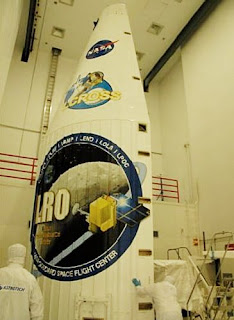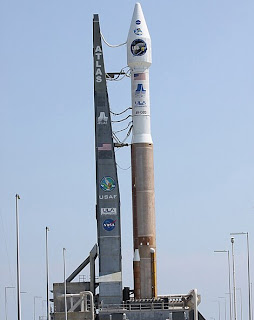 At 2:00pm, I browsed to NASA-TV to see launch preparations for the Lunar Recon Orbiter and the Lunar Crater Observation & Sensing Satellite.
At 2:00pm, I browsed to NASA-TV to see launch preparations for the Lunar Recon Orbiter and the Lunar Crater Observation & Sensing Satellite.The hosts showed the animated trajectory videos from the LRO website, and in between discussions, cameras switched to launch pad views, testers, controllers, etc. The launch itself was delayed due to a nearby thunderstorm, but they took the last window anyway.
I watched the first few burns and maneuvers, and am now awaiting separation… pretty exciting! Well, except that one of the buzzkill announcers emphasized that takeoff was "one tenth of a second late." Geez.
The LRO will spend about a year in polar orbit around the Moon, mapping terrain, seeking safe landing sites and potential resources, and also testing radiation levels. That’s just the short, short, short version of its objectives... which will eventually result in planning and designing a full lunar outpost.
I visit the LRO Blog occasionally, and even if you just glance at their post headers, you’ll get a feel for the amazing amount of technology onboard, all the built-in bells and whistles, plus the sheer amount of testing required for such an animal.
OCTOBER IMPACT
In four months, after making a wide loop around both the Moon and Earth, the LCROSS will watch as the upper stage of a Centaur rocket (yes, the same ones that sent the Surveyor probes to the moon in the 1960s!) slams into a permanently shadowed region near the south pole at about 5,600mph.
 The US, Russia, Europe, India, China and Japan have all crashed orbiters into the moon, the majority of those being deliberate. ;)
The US, Russia, Europe, India, China and Japan have all crashed orbiters into the moon, the majority of those being deliberate. ;)Some were to examine crater formation, soil composition, etc. What’s exciting about the upcoming collision is that scientists hope to absolutely confirm the presence or absence of water -- which is widely argued, based on existing findings.
LCROSS is programmed to follow Centaur downward, and will have about four minutes to fly through the debris plume, using many different cameras to capture all the flying regolith... and possibly ice chips? It will then crash itself into a different part of the same crater. That's darned tight window, so keep your fingers crossed that all the systems operate properly.
Obviously, any identification of water would be incredibly important to any future human activities on the Moon! NASA has an LCROSS Countdown Clock, and I’ll post about it again in October... hopefully with breaking [ice] news!


































































